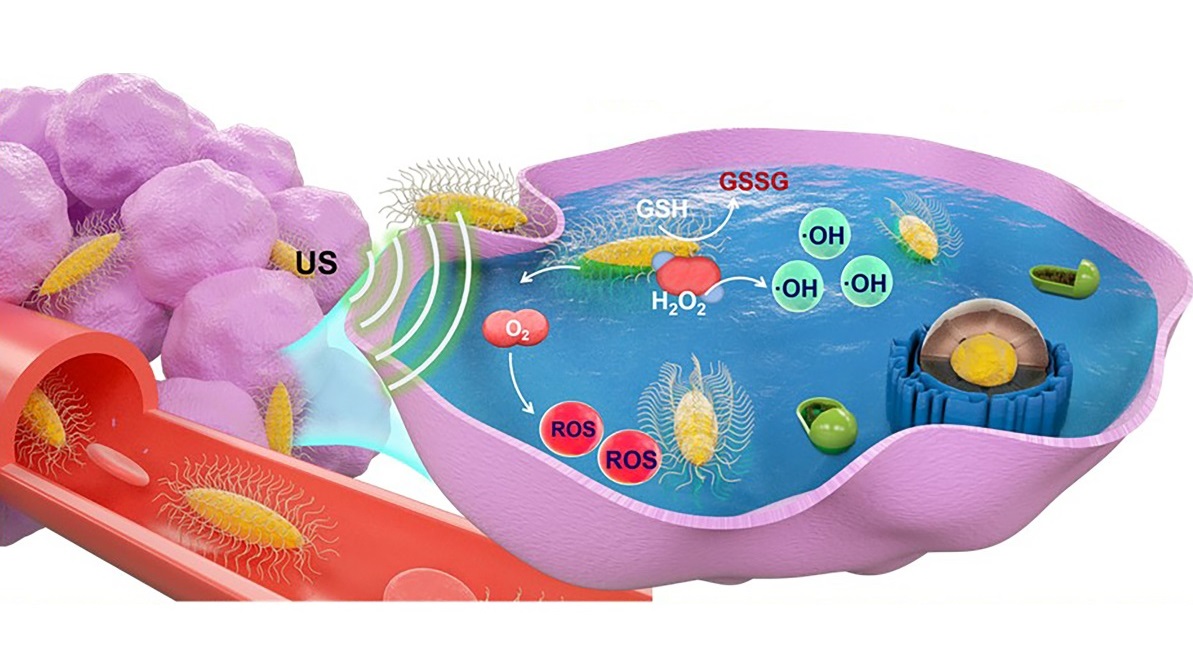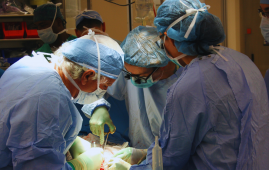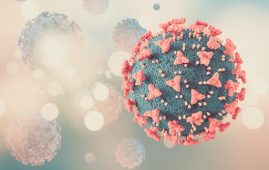

Sonodynamic therapy (SDT) is a promising, non-invasive cancer treatment that uses ultrasound to activate sonosensitizers, which in turn generate reactive oxygen species (ROS) that attack and destroy tumor cells. Researchers from Soochow University in China have developed a new type of sonosensitizer that enhances the amount of damage that SDT can inflict upon tumors without harming normal tissue. Writing in Applied Physics Reviews, they describe how the new sonosensitizer can suppress the growth of human breast cancer tumor cells in mice.
The new sonosensitizer is based on vanadium-doped titanium dioxide (V-TiO2) nanospindles. While TiO2 has been used in the past as a sensitizer, it does not work well because it has a wide bandgap in its electronic structure. This causes electrons stripped away by ultrasound to rapidly recombine with the nanoparticles, preventing the generation of ROS. The researchers determined that if they doped the TiO2 nanoparticles with vanadium to form nano-sized spindles, this would reduce the bandgap, thus increasing the efficiency of ultrasound-triggered ROS production.
Lead author Xianwen Wang and colleagues also determined that vanadium doping causes the nanospindles to act like tiny enzymes that catalyze the generation of highly toxic hydroxyl radicals from hydrogen peroxide contained within the tumor. This provides an additional method of killing the cancer cells, via chemodynamic therapy. Additionally, they report that the nanospindles cause glutathione depletion, which further increases the oxidative stress generated by the chemodynamic–sonodynamic therapy.
The researchers created high-quality V-TiO2 nanospindles and then coated them with polyethylene glycol to create V-TiO2-PEG nanospindles with good water solubility. Following initial testing, they assessed the cytotoxicity of the nanospindles using both non-cancerous human umbilical endothelial vein cells and breast cancer cells. They confirmed that the V-TiO2-PEG nanospindles exhibited no obvious cytotoxicity to the non-cancerous cells but that the viability of the cancerous cells decreased with increasing nanospindle concentration.
The team next examined the therapeutic efficacy of the nanospindles in the cancer cells and in vivo in tumor-bearing mice. The mice were divided into five groups, which received: no treatment (control group); ultrasound irradiation; injection of V-TiO2-PEG nanospindles; injection of commercial TiO2 nanoparticles plus ultrasound; and injection of V-TiO2-PEG nanospindles plus ultrasound.
Tumors in the control group grew rapidly, while the nanospindle-only and the ultrasound-only groups experienced moderate tumor growth suppression. Tumor growth in mice receiving nanoparticles/nanospindles plus ultrasound was markedly suppressed, with the most severe tumor damage and necrosis seen in animals receiving V-TiO2-PEG nanospindles plus ultrasound. ROS staining revealed that tumor sections in this latter group exhibited the strongest fluorescence, indicating that V-TiO2-PEG nanospindles plus ultrasound irradiation generated more ROS in tumor tissues than nanospindles or ultrasound alone.
The researchers identified V-TiO2-PEG nanospindles in the spleen and liver of the mice and, later, in the animals’ feces and urine. They did not detect any obvious signs of organ inflammation or damage. “It is worth noting that the V-TiO2 nanospindles are rapidly excreted from the body,” comments co-author Liang Cheng. “This helps prevent any possible long-term toxicity effects.”
“Our all-in-one nano-platform based on V-TiO2 nanospindles with tumor microenvironment modulating properties enhances sonodynamic therapy against cancer,” conclude the researchers.
more recommended stories
 Safer Allogeneic Stem Cell Transplants with Treg Therapy
Safer Allogeneic Stem Cell Transplants with Treg TherapyA new preclinical study from the.
 Autoimmune Disorders: ADA2 as a Therapeutic Target
Autoimmune Disorders: ADA2 as a Therapeutic TargetAdenosine deaminase 2 (ADA2) has emerged.
 Kaempferol: A Breakthrough in Allergy Management
Kaempferol: A Breakthrough in Allergy ManagementKaempferol, a dietary flavonoid found in.
 Early Milk Cereal Drinks May Spur Infant Weight Gain
Early Milk Cereal Drinks May Spur Infant Weight GainNew research published in Acta Paediatrica.
 TaVNS: A Breakthrough for Chronic Insomnia Treatment
TaVNS: A Breakthrough for Chronic Insomnia TreatmentA recent study conducted by the.
 First-of-Its-Kind Gene-Edited Pig Kidney: Towana’s New Life
First-of-Its-Kind Gene-Edited Pig Kidney: Towana’s New LifeSurgeons at NYU Langone Health have.
 Just-in-Time Training Improves Success & Patient Safety
Just-in-Time Training Improves Success & Patient SafetyA study published in The BMJ.
 ChatGPT Excels in Medical Summaries, Lacks Field-Specific Relevance
ChatGPT Excels in Medical Summaries, Lacks Field-Specific RelevanceIn a recent study published in.
 Study finds automated decision minimizes high-risk medicine combinations in ICU patients
Study finds automated decision minimizes high-risk medicine combinations in ICU patientsA multicenter study coordinated by Amsterdam.
 Study Discovers Connection Between Omicron Infection and Brain Structure Changes in Men
Study Discovers Connection Between Omicron Infection and Brain Structure Changes in MenA recent study in the JAMA.

Leave a Comment